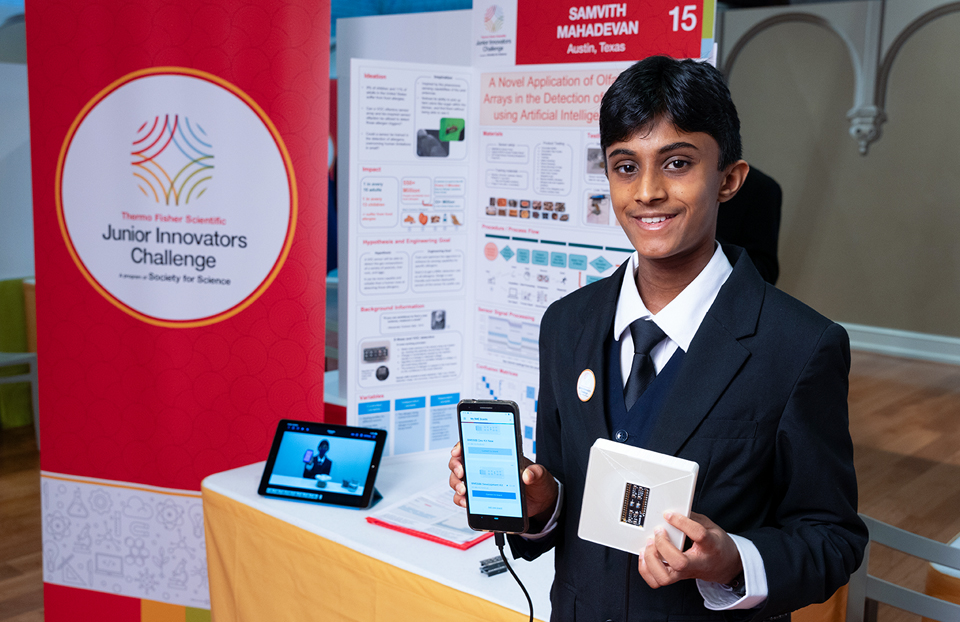Alumni, Broadcom MASTERS, Thermo Fisher JIC
Five Questions with Rory Hu, winner of the $10,000 DoD STEM Talent Award

Though seventh grader Rory Hu is just 13, she has already accomplished quite a bit in the scientific realm. Rory’s project and participation in the Society for Science middle school STEM competition has earned her the $10,000 STEM Talent Award from the Department of Defense in the Broadcom MASTERS, now known as the Thermo Fisher Scientific Junior Innovators Challenge.
With the honeybee population declining at a steady rate, Rory centered her project on understanding if tea polyphenols and caffeine could potentially repair the learning and memory of honeybees after exposure to pesticides. Research has shown that honeybees get lost because of this detrimental exposure to these harmful chemicals. Rory conducted a two-part experiment; one part focused on spatial learning and the other on Pavlovian-based learning. She found that tea polyphenols and caffeine were able to repair the learning and memory of honeybees. Her passion for the environment and drive to make an impact has motivated Rory to continue this research, helping to strengthen our understanding of the distinctions between visual and olfactory learning and memory.
When asked what advice she would give to future scientists, Rory emphasized the importance of expressing oneself fully through science. She believes that research is not about “fancy jargon or awards,” but rather, it is about using one’s passions to further scientific knowledge and discovery. Rory encourages her peers to explore questions that genuinely pique their interests. Her accomplishments at such a young age are a testament to the fact that age is just a number when it comes to making a difference in the world of STEM.
Let’s hear more from Rory below.
Which sci-fi advancement do you wish we had by now?
One sci-fi advancement that would be beneficial in real life would be a hologram that could only be viewed by a designated person. That way, people could virtually explore a 3D object without worrying about others seeing it, thus allowing easier digital communication while maintaining the benefit of privacy.
Which scientist – alive or deceased – would you want to solve scientific mysteries with and why?
I would want to solve scientific mysteries with Lise Meitner. Many believe that she should have shared the 1944 Nobel Prize in Physics with Otto Hahn for her work in nuclear fission. In fact, element 109, meitnerium, was later named after the 20th-century physicist. Lise Meitner is one of the brilliant but widely forgotten Cold War scientists, and I would love the opportunity to be able to learn from her.
What would you invent if you had all the resources in the world?
If I had all the resources in the world, I would invent a low-cost, capable robot nurse that could provide help to seniors with dementia. Especially during the pandemic, seniors are isolated from family and friends, and robot nurses could be the companion and help that they need. Robot nurses like this already exist on the market, but they are too expensive for most to afford and sometimes make mistakes. I would like to improve the accuracy and lower the cost of robot nurses so seniors can have a caring companion without worrying about the drawbacks.
What about your experience at the competition surprised you the most?
I think what was the most surprising was that throughout the Finals Week experience, I felt not as if I was competing against the other finalists but rather learning from and growing with them. Even though we had all come to Washington D.C. for a competition, we ended up bonding together more than I ever imagined, and that held even after the winners were announced.
What was your most memorable experience from the competition this year?
I cherished each moment during Finals Week as time spent in the company of kids who love science as much as I do. Moments such as mealtimes or bus rides gave me a chance to socialize, destress and share ideas with the other amazing finalists, while the competition allowed me to learn both in terms of science and collaboration skills. If I had to pick one, I would probably choose seining and learning about the blue crab at the Smithsonian Environmental Research Center as my favorite memory because it was a physical activity I had never tried before combined with fascinating new knowledge about biology.
The application for the 2023 Thermo Fisher Scientific Junior Innovators Challenge (JIC) is now open! The deadline is June 14, 2023 at 8p.m. ET. Learn more here. The Thermo Fisher JIC (formerly known as the Broadcom MASTERS) is Society for Science’s national STEM competition for middle school students, sponsored by Thermo Fisher Scientific. Nominees are chosen among the top 10% of the 6th, 7th, and 8th-grade competitors at Society-affiliated science and engineering fairs in the United States.


